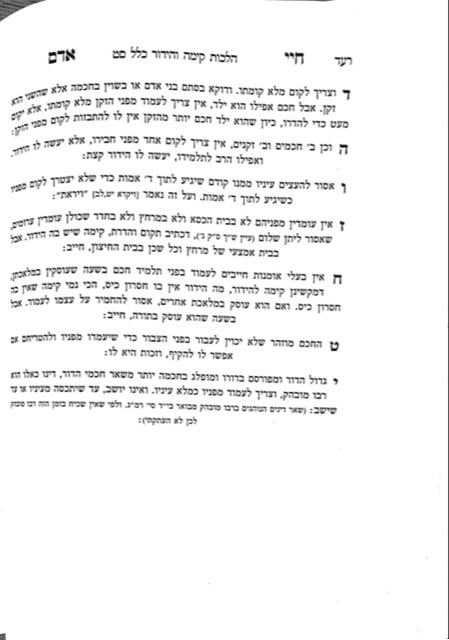We have finished simanim 4-5, which discussed the times and places in which one is chayav to stand melo komaso (to full height) for a talmid chacham or seivah. We left off with the question that although these appear to be straightforward halachos, we see that many do not seem to fulfill this mitzvah to its proper extent.
It is interesting that this question is not a new issue, as the Shach, who lived in the 1600’s, raises this question. He does not dismiss the question by answering that people simply do not follow the halacha, but suggests that “in order to avoid differentiating between different talmidei chachamim, people made a standard approach in which they no longer stand up”.
There is a set of seforim called ve’ahavta le’reiacha kamocha, which discusses interpersonal responsibilities. In volume 6, he suggests an explanation to the Shach. This explanation is also brought by Rav Yosef Chaim Sonnenfeld and Rav Ovadia Yosef.
Although the chiyuv to stand up for talmidei chachamim sounds pretty straightforward, we could run into the following problem. If a person thinks they are a talmid chacham, while others around them think (or know) he is not a talmid chacham, it will create tremendous discord and machlokes between people. Therefore, talmidei chachamim were mochel on their kavod for people to stand up for them, in order to avoid this issue. The Gemara states explicitly that a talmid chacham is allowed to be mochel on their kavod. Exceptions may include a rav of a community or av beis din, where the tzibbur collectively considers this person of stature, but we assume that other talmidei chachamim are mochel.
The sefer ve’ahavta le’reiacha kamocha continues, and points out that although this may explain why we do not stand up for talmidei chachamim, it does not explain why we do not stand up for the elderly. He suggests that standing up for the elderly is an adjunct to standing up for talmidei chachamim. An elderly person may not be a learned person themselves, but has what to offer from a Torah perspective due to their practical experiences, such as the gedolim they have witnessed and so on. Therefore, if we no longer stand up for talmidei chachamim, it would be a bizayon to stand up for the elderly, whose mitzvah is just an adjunct to the mitzvah to stand for talmidei chachamim.
The sefer concludes that, although this may be the reason behind why people no longer stand up, it is still appropriate to occasionally show hiddur towards talmidei chachamim, if not as a mitzvah chiyuvis, but at least as a mitzvah kiyumis (i.e., not because it is mandatory but as a voluntary mitzvah).
Summary
The Shach explains that the minhag has become to refrain from standing up for all talmidei chachamim and elderly, in order to not cause situations of machlokes and discord. Nevertheless, it is still appropriate to stand up occasionally.



